- Although it may sound implausible, there exists a considerable
body of evidence that shows under certain conditions that matter can pass
through other matter. This unusual effect is temporary in nature. We will
also explore several examples of this phenomena. The term "transparency"
or "transparent" refers to a temporary, altered state of
an object which permits it to pass through other matter unaffected.
This is similar to how a dropped rock falls to the ground without being
affected by the air.
-
- For these objects to be found where they were, would
require at least one of the following theories to apply:
-
- 1. NATURAL WEATHER RELATED CAUSES - A tornado, lightning or
other naturally forming energy system under the right conditions can transport
objects to the place where they were found.Objects that became transparent
fall through solid earth and rock briefly, until their transparent state
returns to a solid state. At the place they re-materialize is where they
are found. If this theory is true, with a free-fall rate 10m/s/s. [1] for
any object on earth we can readily calculate how long this transparent
state lasts (units of measurement will be measured in seconds or fractions
of a second.)
-
-
-
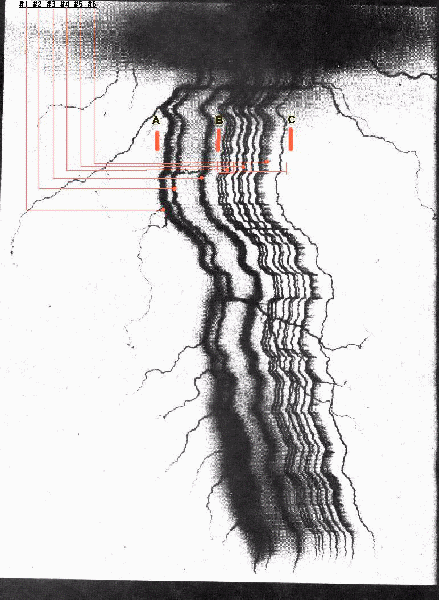
-
- LIGHTNING TIME LAPSE PHOTO
- (Photo from Warren York)
-
-
- The above is a time lapse reverse image photo of lightning.
Although lightning is a natural event considered to be random, it is readily
observable in this unaltered image (except for the notations superimposed
on it) that repetition has indeed taken place.
-
-
- Mr. York, a research associate of mine with alternative
theories to mainstream physics has explained the repetitive lightning in
the image. The following extract is from his text. He has given
me permission to include his theory in this document. My comments
are enclosed in {}. I have used the term "bolt" to describe a
single electrical discharge inside one strike.
-
-
- 'There are lightning bolts that can align perfectly,
as shown in the one above image taken with a swing camera. It
is my claim that as seen by the naked eye, it will appear
there is only one strike. Yet we can see with real time photography,
this strike consists of multiple bolts and not just one strike.
If this is true, you should get sets of three - the single bolt before
actual time it first happened because of a reverse time shift, a single
orignal bolt in the present time frame, and then one after the orignal
bolt {see notations in red on the above image.} My theory predicts you
should also get three sets of each group as shown above. This photo follows
the theory as predicted.
-
-
- To engineer time, we should find some examples of time
jumps taking place in nature. Man watched birds fly until he
was able to do the same {with aircraft.} This could also serve as an example for
duplicating time jumps. Nature accomplishes time jumps at the atomic
level through tunneling. Nature may be very well be accomplishing
this effect with lightning.
-
- In high energy lightning strikes with multiple bolts
such as those show above, a split in the space/time fabric may be created.
What gave me insight into this, is that high energy bolts using the
same path of the original bolt do not differ.
-
-
- If these bolts were NOT the result of subsequent discharges
following the same ionized path [formed by the leader stroke,]
then:
-
-
- a. Multiple bolts traveling between the cloud and ground in the
same strike will differ.
- b. The pattern will not match up 100 percent.
-
-
- [We also do not know if this multiple bolt phenomena
takes place in cloud to cloud lightning, or what effect this may have on
aircraft. Colored sprites which have been observed in the upper atmosphere above
thunderstorms from the space shuttle and from cameras in high altitude
ballons, could be related to this phenomena.]
-
- 2. MAN-MADE TRANSPORT - Objects were transported to their
final location by a man-made warp or matter manipulation technology,
most likely the result of unintentional side-effects of man-made time
jump technology. Planetary time jumps have already been observed taking
place. Objects are often found at depths of around 100ft. Therefore, a
coordinate offset between the source location and the final destination
must have ocurred (see the author's website at http://www.data4science.net
for more observations from many people around the earth on time jump effects.)
-
- 3. EXISTING MATERIAL - The earth was created from existing
matter and recycled raw materials. Objects found in wrong places are part
of the "raw materials" used from another destroyed planet,
probably earth-like in nature. Some theories state that a tenth planet
was destroyed and became our solar system's asteroid belt. It may also
help explain how precious stones and other objects are sometimes found
in clusters or in unlikely places [4].
-
- 4. NO UNUSUAL PHENOMENA INVOLVED - Objects found
were always unmoved and where they were dropped by someone in ancient
history. Then over time rock buried them. Yet Sumerian records seem to indicate
we have already been through at least one other "civilized" era.
Each era was almost completely destroyed, such that little or no record
of it exists. Records about artifacts may have been completely destroyed,
but large bits and pieces of past civilizations still exist that are hard
to destroy. The pyramids and the Sphinx are good examples of this. Very
high heat may have played a role in the destruction of past civilizations.
-
- 5. TECHNOLOGY USED ON A PARALLEL WORLD - Objects
were transported from a parallel earth to their present location on this
earth, via an unknown technology. This may be the result of physics
experiments taking place on a another parallel earth. It would indicate
that the test object used in the other world vanished and was never
seen again. There are no existing rules which state an even exchange of
matter must take place. The original location of the object on another
parallel earth, may likewise correspond to an underground location somewhere
on our earth (i.e., a coordinate offset would exist.) A bigger question
is raised with this theory - if all objects that appear on earth are the
result of this technology, then why is that older 19th century type
objects or anicent coins are found, and not something much more
modern? Did the other earth cease to exist or stop using the technology?
Or, perhaps it was perfected and lost objects no longer occur.
-
-
- 6. OBJECTS ARE FAKE - All the objects found are fakes.
However, there are credible witnesses such as museum directors and scientists.
These people would have everything to lose and nothing to gain from being
associated with such fraud. If just one object is man-made which is found
deep in the ground, then the entire phenomena must also be real regardless
of the cause.
-
-
- The common question applies to most of the above
theories - why are none of the objects found to be of of recent design
from the past 20 years?
-
- MAN-MADE METAL OBJECTS IN ANCIENT ROCK
-
- Various objects have been found inside coal, often discovered
accidentally when a piece of coal was dropped on the floor which splits
open. Coal is considered by geologists as extremely old organic
material. This causes one to pause and wonder how many items have
been inside coal, but were destroyed in furnaces and stoves because they
were never discovered. In any case, we know that somehow these objects
were transported from where they were manufactured to where they were found, via
a phenomena not easily explained.
-
- CARBON-14 DATING CONSIDERATIONS
-
- Carbon dating has been proven to be unreliable when dating
very old objects found in the ground. The problem with Carbon-14 dating,
is that one cannot always tell when it has not worked accurately. Rock
strata and other organic material are often used to determine the age of
an object. Carbon-14 dating in past *assumed* that everything has
the same Carbon-14 absorption from the environment and with the
same decay rate. We now know this is not true. [6]
-
-
- THE FOCUS IS ON WHAT AND WHERE - NOT WHEN
-
- Carbon dating issues aside, only the WHAT and WHERE of
the following objects are relevant to this work. Unlike carbon-14 dating,
these are usually absolutes we can use. We will not focus on the estimated
age. We want to know HOW they got there. Below are just a few well documented
examples of objects found in completely unexpected places. To reduce
the original somewhat lengthy text (see [2] for further reading,)
not all the names of researchers, scientists and museum directors
are included below. For ease of reading and clarity, I have reduced
the original text by approximately 50% without changing any data. It
is also noteworthy that there are almost identical copies
of the orignial text in other places.
-
- Descriptions of objects below are dated 1979 [2].
Some years passed after 1979 before the unreliable nature of the complex
carbon dating process was better understood. Please keep this in mind as you
read the following stories of discovered objects. My comments are enclosed
in { }.
-
- ANCIENT PAUL BUNYAN?
-
- * In 1826, a well dug near the Ohio river from a level
94 feet down, a buried tree stump was brought to the surface which showed
the marks of an ax. The marks were deep and well-cut, indicating the use
of a sharp and durable blade. The suspicion that the ax had been made of
metal was confirmed when, embedded in the top of the stump, an advanced
oxidized wedge of iron was found. The layer from which the stump came was
estimated to be between 50,000 and 75,000 years old - nearly 10 times the
accepted age of the supposed first metal usage. {Question is - HOW did
it get there, 94ft. down?}
-
-
-
-
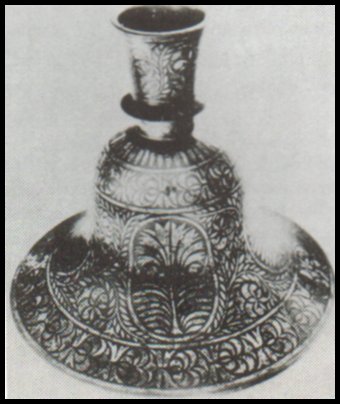
-
- CANDLESTICK HOLDER?
-
-
- * June, 1851 issue of Scientific American (volume 7,
pages 298-299), two parts of a metallic vase dynamited out of solid rock
on Meeting House Hill, Dorchester, Massachusetts. They formed a bell-shaped
vase {candlestick holder?} 4 1/2 inches high, 6 1/2 inches at the base,
2 1/2 inches at the top and an eighth of an inch thick. The metal was an
alloy of zinc and a considerable portion of silver. On the sides were six
figures of a flower in bouquet arrangements, inlaid with pure silver, and
around the lower part a vine, or wreath, also inlaid with silver. The chasing,
carving, and inlaying are exquisitely done by the art of some unknown craftsman
- yet this curiosity was blown out of solid pudding stone from 15 feet
below the surface. Estimated age - 100,000 years. {This ornately designed
object appears to be from a temple.}
-
-
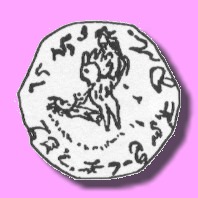
-
- SKETCH OF COIN FOUND AT LAWN RIDGE
-
- * At Lawn Ridge, 20 miles north of Peoria, Illinois,
in August of 1870, three men were drilling a well and the pump brought
up a small metal medallion to the surface from more than 100ft. down. It
appeared in drill residue. W.H. Wilmot in a detailed statement, dated December
4, 1871, described the details of the deposits and depths of materials
present during the boring, and the where the metal "coin" was
uncovered. The strange coin-medallion is composed of an unidentified copper
alloy, about the size and thickness of a U.S. quarter of that period. It
was remarkably uniform in thickness, round, and the edges appeared to have
been cut. Researcher William E. Dubois was convinced that the object had
in fact passed through a rolling mill with the edges showing machining
marks.
-
- Both sides were marked with artwork and hieroglyphics,
as though it had been etched in acid, to a remarkable degree of intricacy.
One side showed the figure of a woman wearing a crown or head-dress. The
opposite side has another central figure, that looks like a crouching animal.
It has long, pointed ears, large eyes and mouth, claw-like arms, and a
long tail frayed at the very end. Below and to the left of it is another
animal, which bears a strong resemblance to a horse. Around the outer edges
of both sides are undecipherable hieroglyphics - and show all the signs
of a form of alphabetic writing. {Someone with the proper background needs
to evaluate this coin.}
-
- Recent calculations {performed in the late 1970's} based
on uniform rates of alluvium deposition and radioisotope dates for this
region estimate an age for materials from just below a depth of 100 feet
to be between 100,000 and 150,000 years. A lost civilization once existed
on the North American continent which worked in copper and other metals;
possessed art and writing; attired themselves with crowns and other clothing;
knew of and perhaps domesticated several animals including the horse; utilized
acids for etching in a manner that is still not understood today; and perhaps
the most disturbing, possessed forms of machinery for the cutting, rolling
and processing of metal pieces.
-
- * Another enigmatic coin came from deep levels in a well
located in Illinois. In 1851, in Whiteside County. A well-drilling bit
brought up from a sand stratum 120 feet deep two copper artifacts: What
appears to be a hook, and a ring. Their age is thought to be the same as
that of the coin - about 150,000 years old.
-
-
-
- UNKNOWN SPARKPLUGS FROM COMPELTELY DIFFERENT
LOCATIONS
-
-
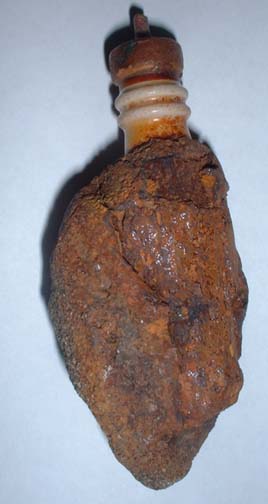
-
-
- ANCIENT SPARK PLUG WHICH WASHED ASHORE IN DELAWARE.
-
-
-
-
-
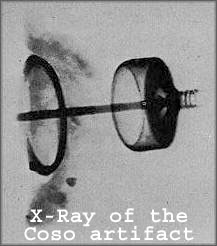
-
-
- X-RAY OF ANCIENT SPARK PLUG
-
-
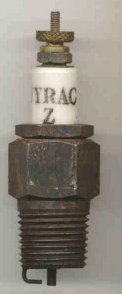
ACTUAL MODEL T PLUG
- FOUND IN CALIFORNIA
-
-
- * On February 13,1961, three rock hunters - Mike Mikesell,
Wallace Lane and Virginia Maxey - were collecting geodes about 12 miles
east-southeast of Olancha, California. Geodes are spherical stones with
hollow interiors lined with crystals. On this particular day, while searching
in the Coso Mountains, they found one stone located near the top of a peak
approximately 4,300 feet in elevation and about 340 feet above the dry
bed of Owens Lake. The next day when Mikesell cut the stone in half. Inside
were the remains of some form of mechanical device (See X-ray above.) Beneath
the outer layer of hardened clay, pebbles and fossil inclusions is a hexagonal
shaped layer of a substance resembling wood, softer than agate or jasper.
This layer forms a casing around a three-quarter inch wide cylinder made
of solid white porcelain or ceramic, and in the center of the cylinder
is a two millimeter shaft of bright, brassy metal. This shaft, the rock
hunters discovered, is magnetic, and after several years of exposure never
showed traces of oxidation. Also, surrounding the ceramic cylinder are
rings of copper, much of them now corroded. Also embedded in the rock,
though separate from the cylinder, are two more man-made items - what look
like a nail and a washer. The rock in which the electrical instrument
was found was dated by a competent geologist at 500,000 years old. {Many
who have seen this object, including this author believe it to be a spark
plug of unknown origin. However, it is unlike any known to have been manufactured
in the past century on earth.} [8]
-
- NAILS
-
- * The Illinois Springfield Republican reported in 1851
that a businessman named Hiram de Witt had a piece of auriferous quartz
rock about the size of a man's fist. In the center of the quartz they discovered
a cut-iron nail, six-penny size, slightly corroded but entirely straight,
with a perfect head. The quartz was given an age of over one million years.
-
- * In Madrid 1572 there is an account of the Spanish Viceroy
in Peru and a strange artifact. Indian miners removed from a subsurface
layer of gravel a large conglomerate boulder, and broke it into piece.
As the mass shattered to the hammer blow, out of the center of it fell
a perfect six-inch nail. The nail was thoroughly examined, and verified
its finding. Iron was unknown to the Peruvian Indians. The rock from which
the nail was freed was 75,000 to 100,000 years in age.
-
- * In 1844, Sir David Brewster made a report to the British
Association for the Advancement of Science. A nail of obvious human manufacture
had been found half-embedded in a sandstone block excavated from the Kindgoodie
Quarry near Inchyra, in northern Britain. It was badly corroded, but identifiable
nonetheless. The sandstone was determined to be at least 40 million years
old.
-
- SCREW
-
- * In 1865, a two-inch metal screw was discovered in a
piece of feldspar unearthed from the Abbey Mine in Treasure City, Nevada.
The screw had long ago oxidized, but its form - particularly the shape
of its threads - could be clearly seen in the feldspar. The stone was calculated
to be 21 million years in age. {Other spring-like objects have been found
in the high mountains of Russia, made of molybdenum and iridium.}
-
-
- IRON CUBE
-
- * In the fall of 1885, at an iron foundry in Upper Austria,
a workman named Riedl was breaking up a block of tertiary brown coal to
heat the foundry's giant smelters. Out dropped a strange cube-like object.
In 1886, mining engineer Dr. Adolf Gurlt noted that the object, coated
with a thin layer of rust, is made of iron and measures 2.64 by 2.64 by
1.85 inches, weighs 1.73 lbs.., and has a specific gravity measurement
of 7.75. Four of the iron "cube's" sides are roughly flat, while
the two remaining sides - opposite each other - are convex. A fairly deep
groove was incised all the way around the object, about mid-way up its
height. Other early studies on the iron artifact were in scientific journals
of the day as Nature (London; November 11, 1886, page 36) and L'Astronomie
(Paris; 1886, page 463). The iron cube is presently in the custody of Herrn
O.R. Bernhardt of the Heimathaus Museum in Vocklabruck.
-
- In 1966-67, the iron "cube" was carefully analyzed
by experts at the Vienna Natural History Museum using electron-beam microanalysis.
They found no traces of nickel, chromium or cobalt in the iron - which
means the object was not of meteoric origin. No sulfur was detected either,
ruling out the chance of it being a pyrite. Because of a low magnesium
content, the object was made of cast-iron. In 1973, Hubert Mattlianer
concluded from yet another detailed investigation that the object had been
made from a hand-sculptured lump of wax or clay pressed into a sand base,
this forming the mold into which the iron had been poured. The final conclusion,
then, is that the strange object is definitely man-made. What is not explained
is what it was doing encased in coal dating to the Tertiary - 60 million
years old.
-
- METAL NODULES
-
- * In 1968, unusual metal nodules were found entombed
in an Aptian chalk bed in a quarry at Saint-Jean de Livet. The nodules
are reddish brown, wafer-shaped and hollowed at the ends, measuring from
3 to 9 centimeters long and 1 to four centimeters wide. But what had these
man-made objects been doing in chalk beds dating toward the end of the
Cretaceous - over 120 million years?
-
- GOLD CHAIN
-
- * On June 9, 1891, Mrs. S.W. Culp of Morrisonville, Illinois
was shoveling coal into her kitchen stove when a large lump broke in two
and out from the center of it fell a gold chain. The chain was about 10
inches long, made of eight carat gold, weighed 8 pennyweight, and was described
as being "of antique and quaint workmanship." Investigators were
convinced the chain had not simply been accidentally dropped in with the
coal: One portion of the coal lump still clung to the chain, while the
part that had separated from it still bore the impression of where the
chain had been encased. In this case, the "curious" "dropped
out" of a piece of coal from the Pennsylvanian era - over 300 million
years old.
-
- IRON POT
-
- * Similar events produced another metal object of even
greater age. In 1912, two employees of the Municipal Electric Plant of
Thomas, Oklahoma, were shoveling coal into the plant furnaces, using fuel
which had been mined near neighboring Wilberton. One chunk of coal was
too large to handle, so the workmen took a sledge hammer to it. Workmen
found that the chunk contained an iron pot, and upon its removal, the two
coal halves bore the "mold" of the pot in its interiors. Both
employees signed affidavits testifying to the authenticity of the discovery,
and the iron pot was subsequently examined by several experts - every one
of which was most reluctant to comment on the pot, and the circumstances
surrounding its discovery. This was most understandable, {?} since
the object came from coal dated from 300 to 325 million years.
-
-

-
- BRASS BELL FOUND IN COAL
-
- In 1944 Newton Anderson claimed to have found a bell
inside a lump of coal that was mined near his house in West Virginia. When
Newton dropped the lump it broke, revealing a bell encased inside. What
is a brass bell with an iron clapper doing in coal that is supposed to
be hundreds of millions of years old? According to Norm Scharbough's book
Ammunition (which includes a compilation of many such "coal anecdotes")
the bell was extensively analyzed at the University of Oklahoma and it
was found to contain an unusual mixture of metals, different from any modern
usage. Photo and text from Genesis Park.
-
-
-
-
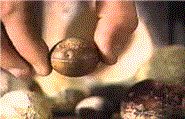
-
- MYSTERY SPHERES STUMP CALIFORNIA EXPERTS
-
-
-
- Stones (such as shown above) were found in rock that
scientists say are billions of years old- and which rotate on their axes,
captured the attention of Mr. John Hund of Pietersburg fifteen years ago....
-
- While playing with the stone on a very flat surface at
a restaurant one day, Hund realized it was very well balanced. He took
it to the California Space Institute at the University of California to
have tests done to determine just how well balanced it was. "It turned
out that the balance is so fine, it exceeded the limit of their measuring
technology and these are the guys who make gyrocompasses for NASA. The
stone is balanced to within one-hundred thousandths of an inch from absolute
perfection," explains Hund.
-
- Nobody knows what these stones are. One NASA scientist
reportedly told Hund that they do not have the technology to create anything
as finely balanced as this. He said the only way that either nature or
human technology could create something so finely balanced would be in
zero gravity [7].
-
-
- CAN A TORNADO CAUSE A DISTORTION OF LOCAL SPACE-TIME?
-
- It was observed several years ago that tornados
can cause a piece of field straw to penetrate a window pane without breaking
it. The straw was stuck in the glass, protruding partly on the inside.
In another case, a rubber tire appeared after a tornado surrounding a telephone
pole - a pole that had a wooden crossbar and power lines on top.
It's most unlikely this was faked, as the tire was not cut. [3]
-
- These and other documented cases appear to demonstrate
that when sufficient energy of the right form is present, matter can momentarily
pass through matter transparently and then re-solidify. The implications
of this are tremendous.
-
- TIME CHANGE DETECTION EXPERIMENT FOR A TORNADO
-
- This experiment would employ two synchronized precision
digital stopwatches or quartz controlled oscillators. One watch would
be located several miles from a tornado, while another watch would be located
as close to the funnel's path as possible. It would be bolted to something
like concrete anchored in the ground to prevent losing it. It would also
need to be protected against flying debris. After the tornado passes, a
change in the flow of time may or may not be visible when comparing the
two watches. I believe it will be possible to observe a change in the flow
of time using sufficiently accurate and stable devices. {Please email me
if you are interested in doing this for more instructions.}
-
- MAN-MADE SPACE-TIME DISTORTIONS
-
- The transparency effect (matter passing through matter)
may also be related to the vortex effect. Vortices were created by
Victor Shauberger [5] almost 100 years ago. He also constructed devices
which could tap into zero point energy using spiral tubing and high velocity
pumped water. High velocity water passing through tubing is known to cause
a faint glow in the dark. Gravitational effects were also observed by Shauberger
such as a reduction in weight. Changes in an objects weight as a result
of an applied energy field, will cause a proportionate change in the
flow of time for that object.
-
- Rotating energy fields generated during the Philadelphia
Experiment created lethal problems. This included disappearing animals
and other animals which went mad. These were so severe Nicola Tesla, a
lead engineer on the project, resigned in protest. He stated that it was
unsafe for sailors to participate in, after seeing the missing and mad
animals. The experiment to say the least, was not well controlled and still
continued. Uncontrolled re-solidification of matter had a lethal, terrifying
side effect on test subjects.
-
-
- HERKIMER DIAMONDS - CREATED BY NATURE
-
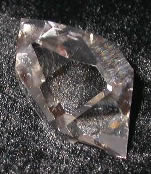
-
- HERKIMER DIAMOND MEASURING ALMOST AN INCH IN
SIZE.
- NOTE THE UNEXPLAINED NATURAL CLARITY WITHOUT
POLISHING
-
-
- In Herkimer, New York [4] are open pit "diamond"
mines. Herkimer diamonds are actually double terminated quartz crystals with
amazing clarity. It is believed to be one of the few places in America
where clear, double terminated quartz crystals are found. The majority
of the Herkimer Diamonds have eighteen faces. Six triangular faces form
the termination points on each end of the crystal. These are separated
by a group of six square or rectangular faces. This arrangement often results
in a diamond shape. Variance in the plane of a face surface on a Herkimer
Diamond has been measured at less than two thousandths of an inch. Even
with today's technology, man has a tough time duplicating the precision
which nature has performed on the Herkimer Diamond. (That is - if nature
formed it.)
-
- What makes these semi-precious gems most interesting,
is where these crystals are always found. Not in a stream, or deep in the
ground. These crystals are found inside dolomite. Dolomite rock
is gray and is essentially bedrock. It is also VERY hard rock, much like
granite. It is commonly known as "crusher run" and used for driveways.
A sledge hammer blow will bounce off dolomite, barely leaving a mark.
A showroom in Herkimer, NY has several very large crystals on display.
Some are about 2" in size (see above) and are often inside a hollow
cavity in a large piece of dolomite. One bigger question here is - WHY are
these crystals inside the rock, and how could they form there? These crystals
are sealed up in the hard dolomite for countless millennia, until found
and opened.
-
- CONCLUSION
- There is overwhelming evidence that many objects exist
in the earth that shouldn't be where they are found. There is no clear
explanation as to how they got there. This may also be a clue to evidence
of the manipulation of space-time by an unknown force or energy. An
object's depth provides clues as to how long the effect may last before
it returns to its normal solid state.
-
- From the current data regarding the relatively shallow
depths where objects are found, the transparency effect appears to last
only seconds at the most. Man-made energy fields that cause the transparency
state may last longer than those of nature.
-
- The type and age of an object may also be used to
provide information as to when in time the object was transported, and
from where it originated. Most valuable is an object (such as a coin or
candlestick holder) which is determined to be a genuine mystery because
unusual or unknown materials are detected.
-
-
- These objects can provide an exciting glimpse
into a culture that may have existed on another earth-like walked on this
earth. Could any archeologist ask for anything better than a well preserved
specimen to examine?
-
-
-
- Ted Twietmeyer
-
- (c) 2005 Due to some previous articles being copied
to other websites under sometimes dubious titles, email me first for permission
to repost this on your site. http://www.data4science.net
-
-
- REFERENCES
-
- [1] -Free fall rate explained - see http://www.glenbrook.k12.il.us/gbssci/phys/Class/newtlaws/u2l3e.html
-
- [2] - J.R. Jochmans, Litt.D., 1979
-
- [3] - These oddities were shown on a television documentary
some years ago. Most likely Discovery Channel or TLC. No images on the
web could be found at the time of this writing.
-
-
- [4] - Author has been to an open pit Herkimer mine.
- http://www.herkimerdiamond.com/DiamondHistory.htm
-
-
- [5] - Victor Shauberger (1885 - 1958) was from Australia
and was inspired by the energy in mountain streams. In the 1930's Shauberger
invented many ideas and devices, including free energy devices and water
powered devices for transportation.
-
-
- [6] - Carbon 14 dating problems explained - http://www.ucgstp.org/lit/gn/gn046/datingmethods.htm
-
-
- [7] - Other strange items at http://www.s8int.com/page9.html
-
-
- [8] - More spark plug images at http://www.coasttocoastam.com/gen/page955.html
|